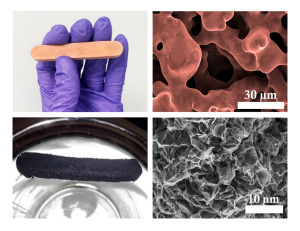Porous graphene-metal composites and graphene foams

A method to make a metal composite containing high-quality graphene (or other 2D-nanomaterial), using industry standard CVD processes The Oxford technique produces a metal composite material with attractive mechanical properties, corrosion resistance and conductivity enhanced by the high quality graphene scaffold. Subsequent metal etching results in a graphene foam (or other 2D nanomaterial foam;) a unique light weight 2D material with high surface area and high conductivity.
New nanomaterial structures to meet market applications
Such new composites can be used for improved aerogels; 3D scaffolds for biological applications; porous conducting electrodes (for supercapacitors, batteries and solar cells). Graphene scaffolds look promising for use as the cathode in Li-air-batteries in electric vehicle systems.
The high surface area of the foam makes them beneficial for application in the following areas:
- next-generation porous electrodes in batteries and supercapacitors
- Filters
- Catalysts
- Thermal Interface Materials
- Corrosion-resistant materials
- 3D Scaffolds for biological materials (hBN)
A low-cost, one-step, up-scalable process
The composite foams are produced using a one-step process in a standard CVD system. Using metal powder and CVD makes it a directly up-scalable process. The CVD system serves two purposes:
- at high temperature and atmospheric pressure the metal (e.g. copper) powder is sintered producing a 3D-porous scaffold.
- a carbon precursor is introduced from an external source with other gases (hydrogen for example) to synthesise high quality, tailorable graphene directly on the metal scaffold.
Other composites containing e.g. boron nitride instead of graphene can be made with this process. The initial investment (standard CVD system) and the cost of source material (metal powder) is low.
Next steps to commercialisation
The Oxford Invention is the subject of a UK patent application. Further refinements and development of the technology are continuing under a number of applied research programmes. Considerable know-how and results are available from this dedicated Nanomaterial-by-design group.
Material samples are available for testing. We are looking for commercial partners to develop a commercial opportunity.
about this technology

